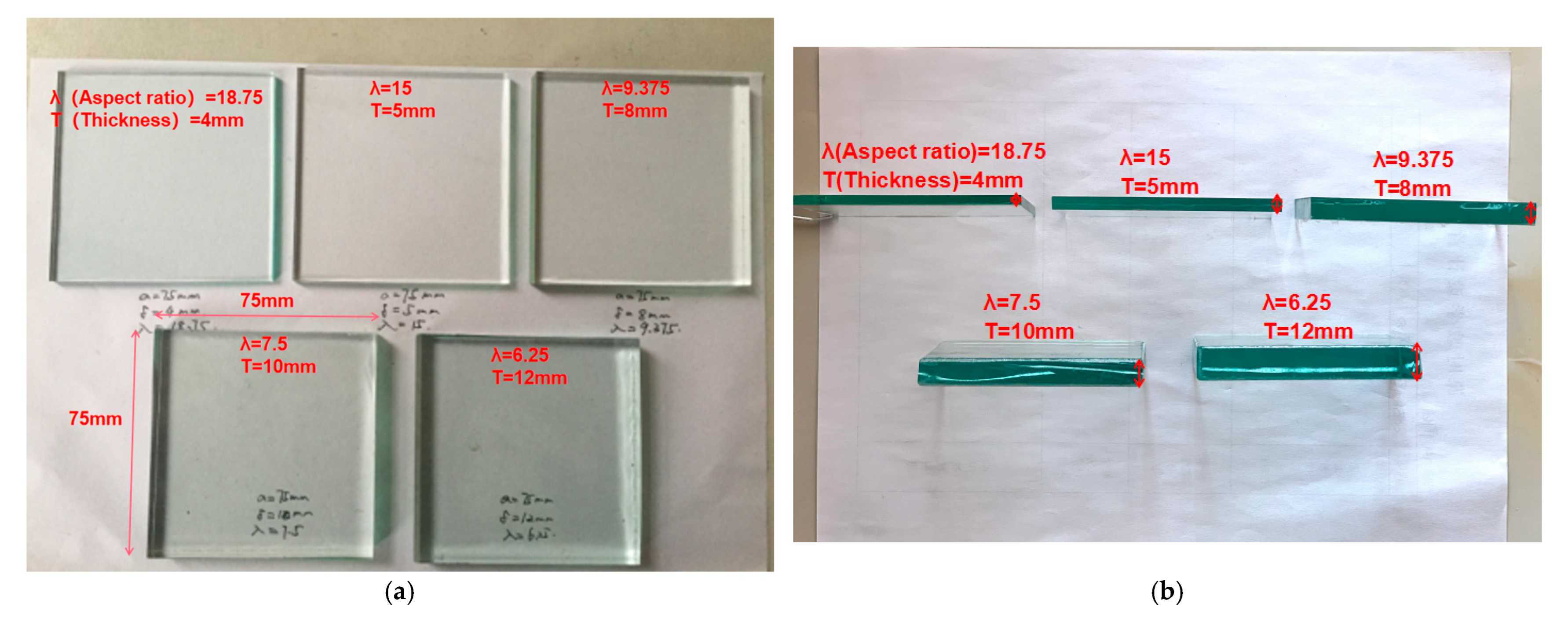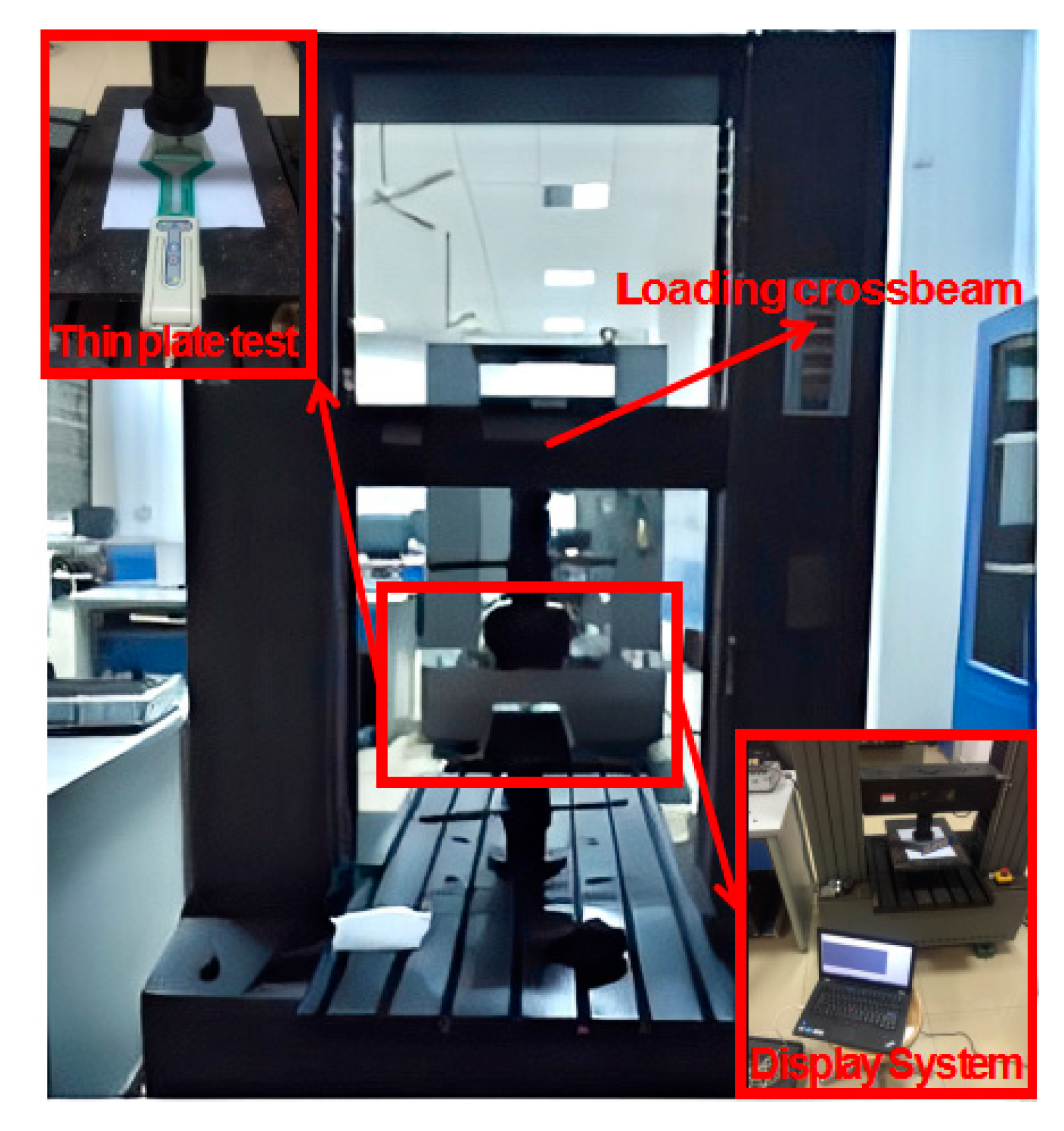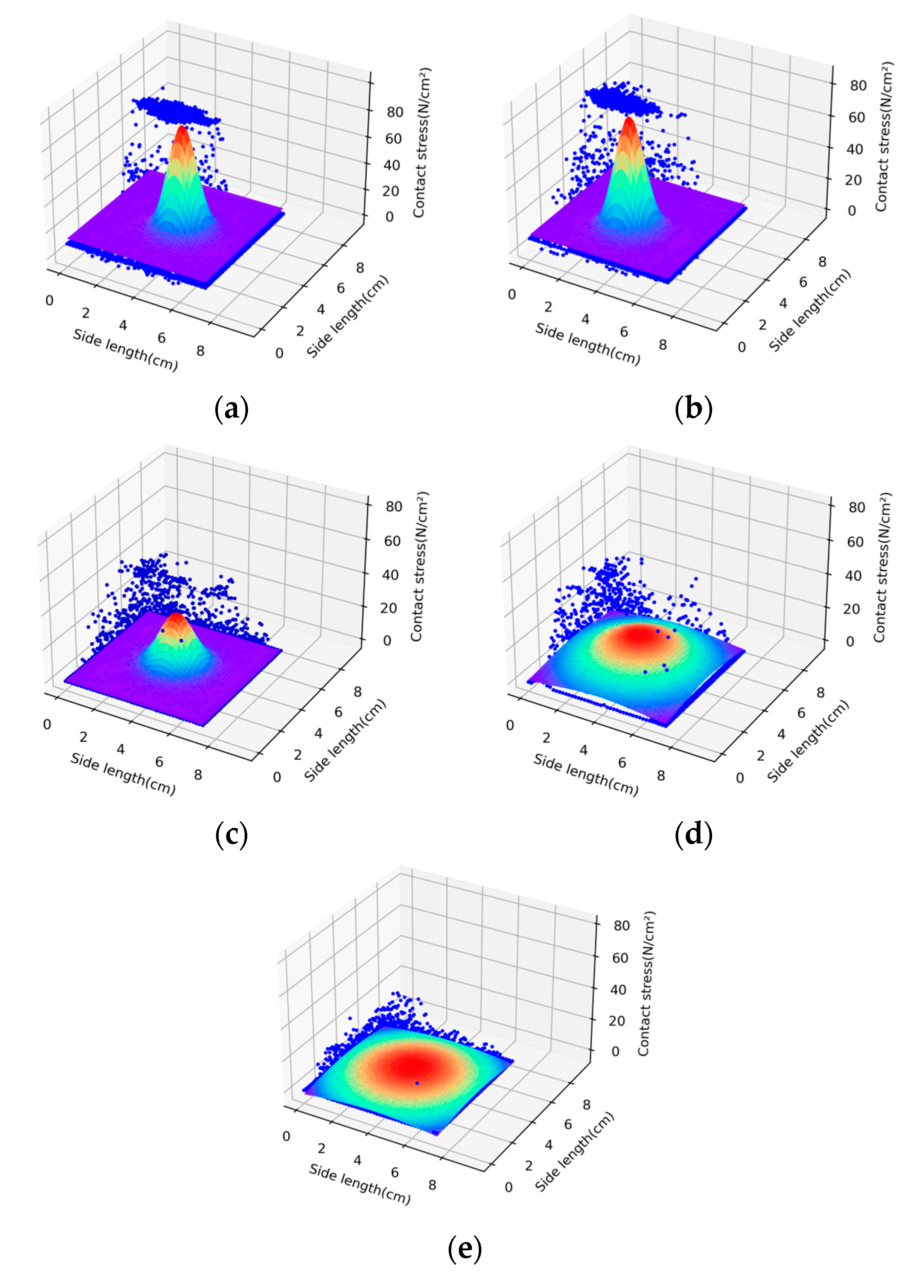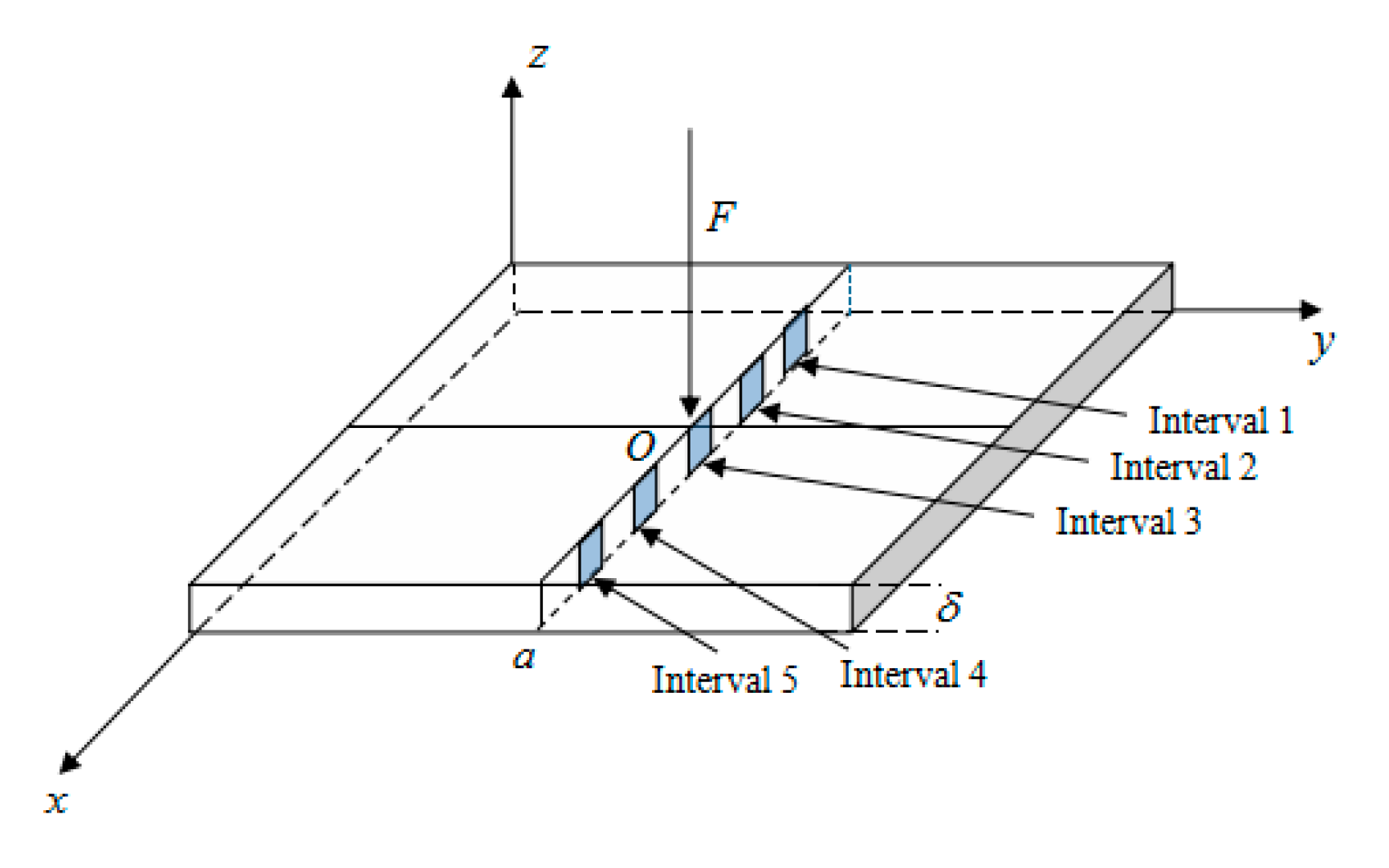Nonlinear Modeling of Contact Stress Distribution in Thin Plate Substrates Subjected to Aspect Ratio
Abstract
:1. Introduction
2. Experimental Programs
2.1. Introduction to Thin Film Pressure Distribution Measurement System
2.2. Experimental Program
3. Test Results and Analysis
3.1. Combined Force Value of Film Pressure Distribution Measurement Results
3.2. Characteristics of Nonlinear Distribution of Contact Stress in Thin Plate Substrate
4. Modeling of Exponential Function Distribution of Contact Stress under Concentrated Load
5. Comparison of Model Results with Experimental Data
5.1. Comparison of Model and Experimental Stress Values of Contact Stress Distribution by Exponential Function
- 1
- For the thin plate with an aspect ratio of 6~8 or more in Figure 9, the contact stress values of the tested bottom plate are nonlinearly distributed, and the exponential function contact stress distribution model is closer to the test results than the original parabolic model, which verifies the correctness of the model in the case of a larger aspect ratio;
- 2
- For the thin plate with an aspect ratio below 6~8, it can be seen from Figure 9 that as the aspect ratio decreases, the contact stress value of the bottom plate is gradually stabilized within a certain stress range, and the exponential function contact stress distribution model and the parabolic model also converge at the same time. This phenomenon shows that when the aspect ratio is small, the exponential function contact stress distribution model and the original parabolic model are equally feasible and can reflect the contact stress distribution.
5.2. Error Analysis of Model and Test Values
6. Conclusions
Author Contributions
Funding
Institutional Review Board Statement
Informed Consent Statement
Data Availability Statement
Conflicts of Interest
References
- Li, A.; Lan, Z. Displacement field and stress field of circular foundation board on elastic semi-space foundation. J. Nanchang Univ. (Sci. Ed.) 2014, 38, 439–445. [Google Scholar]
- Zhang, Z.W.; Zhou, W.J.; Gao, S.; Wan, M.H.; Zhang, W. A novel computational method for dynamic analysis of flexible sandwich plates undergoing large deformation. Eng. Compos. Struct. 2021, 91, 4069–4080. [Google Scholar] [CrossRef]
- Liang, X.; Wang, J.; Liang, Y.F.; Li, Y.Q.; Xiao, M. Research on the distribution of base reaction force and simplified design method for extended foundation with large aspect ratio. J. Sichuan Build. Sci. Res. 2019, 45, 82–87. [Google Scholar]
- Mo, H.; Yang, X. Foundation Engineering, 1st ed.; National Defense Industry Press: Beijing, China, 2003. [Google Scholar]
- Kang, L.Q.; Zhang, J.J.; Yang, Z.C.; Zou, X.Y.; Cheng, H.; Zhang, C. Experimental Investigation on Shear-Stress Partitioning for Flexible Plants with Approximately Zero Basal-to-Frontal Area Ratio in a Wind Tunnel. Bound.-Layer Meteorol. 2018, 169, 251–273. [Google Scholar] [CrossRef]
- Li, C.; Zhu, F. Foundation reaction force test for independent foundation of structural slab. J. Liaoning Univ. Eng. Technol. 2006, 25, 220–222. [Google Scholar]
- Wang, P. Variable Decomposition of Four-Sided Free Rectangular Slabs on Elastic Foundations. Master’s Thesis, Southwest Jiaotong University, Chengdu, China, April 2007. [Google Scholar]
- Wu, R.; Wu, J.B.; Chen, Q.J.; Li, L.F. Analysis of Influencing Factors of Roadway Stability and Adaptability Criterion for Gob-Side Pre-Backfill Driving. Math. Probl. Eng. 2022, 2022, 6601484. [Google Scholar] [CrossRef]
- Wang, G.; Fang, S.; Pan, H. Theory of composite foundations and its engineering applications. J. Hefei Univ. Technol. Nat. Sci. Ed. 2000, 23, 5. [Google Scholar]
- Cheng, X.S. Free edge rectangular slabs on elastic foundations. Appl. Math. Mech. 1992, 13, 345–354. [Google Scholar]
- Yamin, M.M.; Ashteyat, A.M.; Al-Mohd, I.; Mahmoud, E. Numerical Study of Contact Stresses under Foundations Resting on Cohesionless Soil: Effects of Foundation Rigidity and Applied Stress Level. Ksce J. Civ. Eng. 2017, 21, 1107–1114. [Google Scholar] [CrossRef]
- Liang, F.Y.; Liang, X.; Wang, C.; Wang, J.; Li, Y.Q. Influence of Rigidity and Load Condition on the Contact Stress and Settlement Deformation of a Spread Foundation. J. Test. Eval. 2019, 47, 1105–1128. [Google Scholar] [CrossRef]
- Wang, G.; Hu, X.; Pan, H. Numerical simulation of foundation reaction forces and internal force response of foundation structures. J. Civ. Eng. 2002, 35, 103–107. [Google Scholar]
- DL/T5219-2005; The Technical Provisions for the Design of Power Transmission Line Foundations. Development and Reform Commission of the People’s Republic of China: Beijing, China, 2005.
- GB50007-2002; Code for the Design of Building Foundations. Ministry of Construction of the People’s Republic of China, China Architecture and Building Press: Beijing, China, 2002.
- Rezaiee-Pajand, M.; Yaghoobi, M.; Karkon, M. Hybrid Trefftz Formulation for Thin Plate Analysis. Int. J. Comput. Methods 2012, 9, 4. [Google Scholar] [CrossRef]
- Wang, X. Analytical solution of a rectangular elastic thin plate bending problem with two-sided simple support of stepped step type. J. Appl. Mech. 1995, 12, 126–131. [Google Scholar]
- Deng, C.; Kong, W.; Zheng, Y. Lectures on finite element method of limit analysis I. III Incremental loading finite element method for solving ultimate bearing capacity of foundations. Geotech 2005, 26, 500–504. [Google Scholar]
- Zhang, F.F.; Huang, H.M. Free rectangular plates on elastic foundations. Appl. Math. Mech. 1984, 1, 345–353. [Google Scholar]
- Fu, B. Generalized Displacement Theory of Bent Rectangular Plates; Science Press: Beijing, China, 2006. [Google Scholar]
- Guo, Y.; Xiao, Y.; Wu, K. Bending problems of rectangular plates on nonlinear elastic foundations. Highw. Steam Transp. 2007, 1, 75–77. [Google Scholar]
- Mi, Y. Bending of Elastic Foundation Slab under Different Boundary Conditions by Concentrated Load. Master’s Thesis, Yanshan University, Qinhuangdao, China, June 2016. [Google Scholar]
- Chen, H. Bending of Slabs on Non-Uniform Elastic Foundations. Master’s Thesis, Xi’an University of Architecture and Technology, Xi’an, China, May 2012. [Google Scholar]
- Johnson, K.L. Contact Mechanics; Higher Education Press: Beijing, China, 1992. [Google Scholar]
- Huang, M.W.; Zhao, M.Y.; Xu, L.H. Analytical solution of the complex form of the bending problem of rectangular plate on Winkler elastic foundation. J. Nanchang Univ. (Eng. Ed.) 2000, 22, 17–21. [Google Scholar]
- Guan, J.; Zhou, X.; Liu, L.; Ran, M.; Yan, Y. Investigation of Tri-Axial Stress Sensing and Measuring Technology for Tire-Pavement Contact Surface. Coatings 2022, 12, 491. [Google Scholar] [CrossRef]
- Guan, J.; Zhou, X.; Liu, L.; Ran, M. Measurement of Tire-Pavement Contact Tri-Axial Stress Distribution Based on Sensor Array. Coatings 2023, 13, 416. [Google Scholar] [CrossRef]
- Jeong, Y.J.; Kim, Y.E.; Kim, K.J.; Woo, E.J.; Oh, T.I. Multilayered Fabric Pressure Sensor for Real-Time Piezo-Impedance Imaging of Pressure Distribution. IEEE Trans. Instrum. Meas. 2020, 69, 565–572. [Google Scholar] [CrossRef]
- Li, A. Experimental and Numerical Simulation Determination of Contact Stress Distribution Form of Flexible Foundation Base Plate and Analysis of Internal Force of Corresponding Foundation Plate. Ph.D. Thesis, Nanchang University, Nanchang, China, June 2019. [Google Scholar]
- Li, P.; Zhu, Y.S.; Yan, K.; Xiong, Q.Q.; Zhang, Y.Y. Experimental Investigation on the Film Pressure Measurement in Microgap Water-Lubricated Hybrid Journal Bearing. Tribol. Trans. 2017, 60, 814–823. [Google Scholar] [CrossRef]
- Ji, Y.; Zou, Y.; Ma, Y.; Wang, H.; Li, W.; Xu, W. Frost Resistance Investigation of Fiber-Doped Cementitious Composites. Materials 2022, 15, 2226. [Google Scholar] [CrossRef] [PubMed]
- Ji, Y.; Zou, Y.; Li, W. Sulfate erosion investigation on FRP-confined concrete in cold region. Sci. Rep. 2022, 12, 10839. [Google Scholar] [CrossRef] [PubMed]
- Talbi, N.; Fergani, B.; Bensekrane, R. Linear Stress Distribution in a Rectangular Plate with an Elliptical Hole: Influence of Some Geometric Parameters on the Maximum Stresses. Mathematics 2020, 8, 1807. [Google Scholar]
- Mehmet, S.; Selçuk, B.; Mustafa, L. Experimental and Numerical Studies of Vertical Stresses Beneath the Circular Footings on Sand. Appl. Sci. 2023, 13, 1635. [Google Scholar]












| Test Load/N | λ = 18.75 | λ = 15 | λ = 9.375 | λ = 7.5 | λ = 6.25 | |||||
|---|---|---|---|---|---|---|---|---|---|---|
| Measurement Average Value/N | Error | Measurement Average Value/N | Error | Measurement Average Value/N | Error | Measurement Average Value/N | Error | Measurement Average Value/N | Error | |
| 250 | 142.68 | −42.9% | 264.16 | 5.7% | 244.3 | −2.3% | 230.52 | −7.80% | 263.69 | 5.50% |
| 500 | 399.83 | −20.0% | 523.02 | 4.6% | 523.83 | 4.8% | 505.66 | 1.10% | 541.31 | 8.30% |
| 750 | 729.49 | −2.7% | 750.7 | 0.1% | 803.86 | 7.2% | 778.93 | 3.90% | 803 | 7.10% |
| 1000 | 1085.28 | 8.5% | 949.79 | −5.0% | 1069.65 | 7.0% | 1044.14 | 4.40% | 1049.04 | 4.90% |
| 1250 | 1469.82 | 17.6% | 1068.52 | −14.5% | 1333.97 | 6.7% | 1295.76 | 3.70% | 1285.7 | 2.90% |
| Contact Stress Value | Interval 1 | Interval 2 | Interval 3 | Interval 4 | Interval 5 | Percentage Error |
|---|---|---|---|---|---|---|
| Test value | 12.66 | 25.75 | 60.19 | 60.19 | 27.43 | |
| Exponential function model | 11.97 | 23.44 | 56.43 | 57.76 | 26.33 | 3.80% |
| Parabolic model | 11.72 | 29.67 | 40.75 | 41.44 | 32.91 | 21.20% |
| Linear model | 17.78 | 17.78 | 17.78 | 17.78 | 17.78 | 49.49% |
| Contact Stress Value | Interval 1 | Interval 2 | Interval 3 | Interval 4 | Interval 5 | Percentage Error |
|---|---|---|---|---|---|---|
| Test value | 11.49 | 26.12 | 60.02 | 42.46 | 30.01 | |
| Exponential function model | 11.07 | 24.13 | 56.42 | 38.1 | 27.62 | 3.40% |
| Parabolic model | 11.31 | 30.68 | 40.97 | 42.16 | 34.25 | 7.10% |
| Linear model | 17.78 | 17.78 | 17.78 | 17.78 | 17.78 | 51.18% |
| Contact Stress Value | Interval 1 | Interval 2 | Interval 3 | Interval 4 | Interval 5 | Percentage Error |
|---|---|---|---|---|---|---|
| Test value | 9.92 | 21.02 | 23.35 | 29.34 | 23.36 | |
| Exponential function model | 14.25 | 22.66 | 25.99 | 29.75 | 24.56 | 3.20% |
| Parabolic model | 8.86 | 19.97 | 25.89 | 26.7 | 22.38 | 7.95% |
| Linear model | 17.78 | 17.78 | 17.78 | 17.78 | 17.78 | 36.35% |
| Contact Stress Value | Interval 1 | Interval 2 | Interval 3 | Interval 4 | Interval 5 | Percentage Error |
|---|---|---|---|---|---|---|
| Test value | 18.69 | 22.72 | 27.2 | 22.08 | 22.08 | |
| Exponential function model | 18.98 | 22.43 | 24.51 | 24.74 | 23.09 | 4.60% |
| Parabolic model | 10.87 | 14.47 | 15.85 | 15.01 | 11.96 | 39.54% |
| Linear model | 17.78 | 17.78 | 17.78 | 17.78 | 17.78 | 20.03% |
| Contact Stress Value | Interval 1 | Interval 2 | Interval 3 | Interval 4 | Interval 5 | Percentage Error |
|---|---|---|---|---|---|---|
| Test value | 21.86 | 23.49 | 24.72 | 24.31 | 22.88 | |
| Exponential function model | 21.72 | 22.57 | 23.03 | 23.08 | 22.72 | 4.80% |
| Parabolic model | 8.87 | 14.05 | 16.91 | 17.45 | 15.68 | 38.18% |
| Linear model | 17.78 | 17.78 | 17.78 | 17.78 | 17.78 | 24.03% |
Disclaimer/Publisher’s Note: The statements, opinions and data contained in all publications are solely those of the individual author(s) and contributor(s) and not of MDPI and/or the editor(s). MDPI and/or the editor(s) disclaim responsibility for any injury to people or property resulting from any ideas, methods, instructions or products referred to in the content. |
© 2023 by the authors. Licensee MDPI, Basel, Switzerland. This article is an open access article distributed under the terms and conditions of the Creative Commons Attribution (CC BY) license (https://creativecommons.org/licenses/by/4.0/).
Share and Cite
Lv, C.; Wei, H.; Lan, Z.; Wu, P. Nonlinear Modeling of Contact Stress Distribution in Thin Plate Substrates Subjected to Aspect Ratio. Sensors 2023, 23, 4050. https://doi.org/10.3390/s23084050
Lv C, Wei H, Lan Z, Wu P. Nonlinear Modeling of Contact Stress Distribution in Thin Plate Substrates Subjected to Aspect Ratio. Sensors. 2023; 23(8):4050. https://doi.org/10.3390/s23084050
Chicago/Turabian StyleLv, Chao, Huixin Wei, Zhiwen Lan, and Ping Wu. 2023. "Nonlinear Modeling of Contact Stress Distribution in Thin Plate Substrates Subjected to Aspect Ratio" Sensors 23, no. 8: 4050. https://doi.org/10.3390/s23084050
APA StyleLv, C., Wei, H., Lan, Z., & Wu, P. (2023). Nonlinear Modeling of Contact Stress Distribution in Thin Plate Substrates Subjected to Aspect Ratio. Sensors, 23(8), 4050. https://doi.org/10.3390/s23084050





